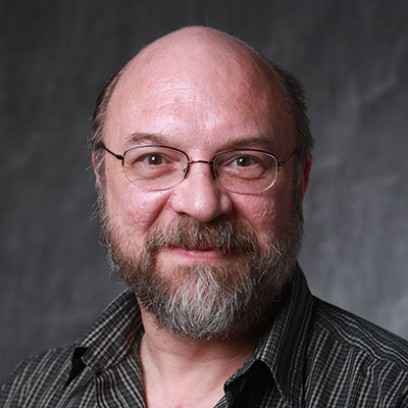
Curtis Bahn
b, US
Musician / Composer of Electronic and Jazz
A.k.a. Curtis R Bahn
Curtis Bahn is an American composer and computer music improviser, instrument designer, retired jazz bassist, an Associate Professor of Music Composition/Interactive Performance and Director of the Graduate Programs in Arts at Rensselaer Polytechnic Institute. Currently based in upstate New York, Bahn received his Ph.D. in music composition from Princeton University. Best known for creating Sbass (Sensor bass) instrument, Curtis Bahn uses basic technology to capture and transmit his gestures to a computer. The sensors on his bow capture touch, angle and distance from the strings, while sensors on the instrument pick up touch, loudness, pitch, etc. This data is processed in real-time on the computer with Max/MSP / Jitter algorithms, and manipulated via live digital signal processing. The audio output is largely based on original bass performance, with other sounds thrown into the mix occasionally. In order to capture the intimacy and intricate detail of his performances, Curtis Bahn also designed Sensor-Speaker-Arrays (SenSAs) – original multi-channel geodesic speaker arrays, which are combined with various sensors and act like acoustic instruments. Initially trained as a traditional jazz bassist, Curtis Bahn had been studying with Stuart Sankey, Edgar Meyer, Murray Grodner, and Marc Johnson (2) in the seventies. He also received a Mingus Award from the International Society of Bassists in 1979. Curtis has worked with free jazz drummer Rashied Ali and saxophonist Bill Evans, among others, but his career never took off on a larger scale, and Bahn's interest in conventional jazz practically evaporated in the 1980s. Curtis Bahn decided to explore an emerging world of computer music instead. A renowned composer Paul Lansky became one of his primary mentors during Bahn's doctoral studies in music composition at Princeton. Soon he met Dan Trueman, a fellow PhD student at Princeton's Music Department, who shared a common interest in gestural instruments design and interactive performance interfaces. They started working on computerized sensors and custom MIDI interface for an electric upright bass and electric violin, which would allow capturing and transmitting data from the instrument to a computer for real-time processing. Curtis Bahn built 'sensor bass,' also known as Sbass – a 5-string electric upright bass fitted with motion, light, touch and tilt sensors. Dan Trueman created a sensor-rigged Rbow, connected to PowerBook G3 laptop, to play on a 6-string electric violin. From 1986 to 1993, Bahn worked as the Technical Director of the Center for Computer Music at CUNY, also studying with a composer Charles Dodge. He later taught at Columbia University, New York University, Princeton University, and City University Of New York, before getting a tenure as an assistant professor at RPI. At Rensselaer's iEAR Studios, Curtis Bahn finished developing Sbass. In the mid-nineties, Trueman and Bahn started performing as interface duo. Joined by Perry Cook on DigitalDoo (electric didgeridoo) and other collaborators, they designed unique sensor-triggered omnidirectional speaker arrays, known as SenSAs. In 2001, interface released . / Swank album on c74 label, endorsed by Max/MSP developers Cycling '74. Two years later, Deep Listening Publications released Recording Field, H DVD, a collaboration with Pauline Oliveros and the first video documentation of interface instruments and performance. Focused on the idea of getting his 'experimental technology' out into the world, in the late nineties Curtis created a portable Rig setup, to fit Sbass, laptop, audio gear and spherical speakers in the car. In 2000, Electronic Music Foundation label released Bahn's debut solo album r!g – a collection of sensor bass and live-electronics improvisations. Stephan Moore (2) and Scott Smallwood, both associated with iEAR Studios, recorded Rebahn – a mail collaboration based entirely on Bahn's r!g album, and dedicated to their teacher and mentor. It was released on Smallwood's Wavelet Records CD-R label. Curtis also produced two collaborative albums with Smallwood, as well as a trio session with Smallwood and shakuhachi player Joel Taylor (6) for Wavelet. One of Bahn's principal collaborators and long-standing partners is a choreographer and shakuhachi performer Tomie Hahn, also an RPI associate professor. For many years, they've been working together on Streams and Pikapika interactive 'sonic characters,' or 'sonic contexts' for live performance. Wearing a custom-built sensor device developed by Bahn, Tomie is able to control all aspects of a virtual sonic ambiance, consisting of synthesized sounds and non-linear poetry, through her movement. With each gesture, Streams recalls bodies of water and land, technology, a flow of information, transmission, and liquid states. According to the composer, a nature of technologies employed in this project allowed them to approach some basic aspects of choreographic collaboration in a fundamentally different way. Rather than structuring time, as in traditional dance/music performances, the concept of Streams was based on 'composing the body.' Curtis Bahn created a sensor system that analyzed all physical attributes of the dancer's movement vocabulary to extract and capture specific gestures, and a parameter-mapping system for the dancer to freely navigate and combine sonic elements. In Streams, Tomie Hahn draws on over 30 years of experience in Japanese traditional and contemporary dance. The sonic palette of the project is a combination of real-time DSP, physical modeling algorithms and pre-recorded sound samples of text. Pikapika was another 'sonic alter ego,' primarily used by Tomie Hahn in performances with interface. This character was inspired by anime and manga, and embodied movements from traditional Japanese bunraku puppet theater. Pikapika had a wireless interactive dance system SSpeaPer, which transmitted gestural data to the computer, and then broadcasted audio output back to her body, projecting sounds from the speakers mounted on Tomie's body. Currently, Curtis Bahn is a Shagird, or formal student of the Sitar, with great virtuoso and master Ustad Shahid Parvez Khan. He traveled extensively in India, accompanying his guru as the Asian Cultural Council's 2012 'Ralph Sameulson Fellow.' Using an Ovation electric sitar (built by Ajay Sharma from Rikhi Ram Musical Instruments in New Delhi) with additional sensor interface, Bahn created an Extended Sitar, or eSitar, which allows him to play the instrument through an interactive Max/MSP patch. In 2007, he formed an international ensemble SekunSak with Aparna Panshikar, Ansuman Biswas, and Lawrence Casserley in New Delhi, India. Curtis Bahn has been actively applying his recent studies in Indian Classical music to contemporary electronic compositions, performing eSitar and electric Dilruba solo, as well as in concert with a human-robotic Machine Orchestra at California Institute Of The Arts, and in duo with Thomas Ciufo. They established a Sonic Constructions improvisational electroacoustic project, with Ciufo playing on the eighth nerve guitar v. 3.0 (an extended electric guitar with slide sensor, accelerometers, additional switches, a pressure and slide sensors on the guitar's neck, and a VGA data connector leading to a custom-built hardware module), as well as flutes, percussion, prepared piano and live electronics. The duo performed at the 14th Biennial Symposium for Arts and Technology, at Towson University in October 2013, and released an eponymous Sonic Constructions CD in 2016, featuring guest flutists Steve Gorn and Jane Rigler. Over the years, his music had been presented internationally at Lincoln Center, Sadler's Wells Theatre, Opéra National De Paris, Palais Garnier, India International Centre in Delhi, Grand Theatre de la Ville in Luxembourg, and other prestigious venues, as well as numerous festivals, academic conferences, and small clubs. He was also a composer for a major interactive dance 'Motione' residency with choreographer Trisha Brown and visual artists Paul Kaiser, Marc Downey and Shelly Eshkar at the Arizona State University.
Instruments
Genres
Plays With
| Interface |
Popular Tracks 

Track list and 30sec audio provided by ![]()
Band Members
Discography
| Title | Artist | Year | Type |
|---|---|---|---|
| Sonic Constructions | Curtis Bahn & Thomas Ciufo | 2016 | Album |
| Turnpike | Curtis Bahn + Scott Smallwood | 2002 | Album |
| r!g | Curtis Bahn | 2000 | Album |
| ISP720-2K | Curtis Bahn, Scott Smallwood, Joel Taylor | 2000 | Album |
| Gilman | Curtis Bahn + Scott Smallwood | Album |
